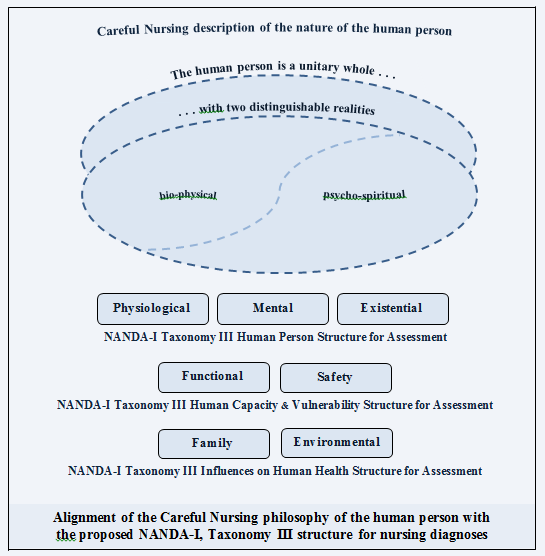Blog
Careful Nursing Philosophy and Demands of Clinical Practice
This reflection concerns two misalignments which arise between Careful Nursing philosophy and clinical practice demands and structures.
The human person as a unitary whole or addition of parts
Firstly, Careful Nursing philosophy argues that the human person is a unitary whole, meaning that a person is not composed of an addition of parts. This was the originally intended meaning of the word holism (Smuts, 1927). If this is true, what do we do in our practice when we are so obviously concerned with the bio-physiological parts of a person; the wound to be dressed or counting the number of respirations per minute?
The answer to this question is usually to redefine holism, and the whole person, as an addition of parts. But this realignment of meaning would not do for Careful Nursing.
Actually, Careful Nursing has a more fitting answer to this question. Our neo-Aristotelian philosopher, Thomas Aquinas, argues in convincing detail that as human persons we are unitary beings. At the same time he explains that as unitary human persons we have two distinguishable realities, a bio-physical reality of body and senses (an outward life) and a psycho-spiritual reality of mind and spirit (an inward life). He emphasises that these are not parts of a person but distinguishable realities critical to our existence and functioning as human persons.
We know this also from our practice experience. Take the nurse-patient relationship. In a unitary way we know that we and the people we care for experience this relationship as a unitary relationship. Its qualities are unitary, for example, our experience of attending to people with benevolence, their experience of our kindness and compassion, and our altered sense of time passing. At the same time we are both absolutely aware; at times critically aware; of the great importance of focused bio-physical and, or, psycho-spiritual care. Skilled practice is attending to the unitary person and the distinguishable reality simultaneously.
A suitable structure for assessment and diagnosis
Secondly, in Careful Nursing a different sort of misalignment can arise in our practice relating to how we approach the assessment of patients and diagnosis of their undesirable human responses, vulnerabilities, and motivations to actualise their potential for healing and health. In hospitals and healthcare systems, structures for assessing people and identifying their nursing diagnoses are usually set by Departments of Nursing, often following a medically oriented, body systems approach. These can be difficult to align with the Careful Nursing philosophy of the human person.
In addition, the practice competence and excellence dimension of the Careful Nursing professional practice model includes the use of standardised nursing languages; for example, the widely used NANDA-I Nursing Diagnoses (Herdman & Kamitsuru, 2014), Nursing Outcomes Classification (Moorhead et al., 2012) and Nursing Interventions Classification (Bulechek et al., 2013). But, as a driver of practice, the current NANDA-I Taxonomy II diagnostic structure does not align easily with Careful Nursing philosophy (or indeed relate directly to the immediate nursing diagnostic needs of acutely ill people).
But, a realignment of Careful Nursing philosophy and these structures may soon be possible using the proposed NANDA-I Taxonomy III structure developed by von Krogh (Herdman, 2014). At the moment the new structure is still under consideration. But if it is adopted it would align more clearly with the Careful Nursing philosophy of the human person, as suggested in the following figure:
Even if the proposed Taxonomy III is not adopted by NANDA-I it still could be useful for Careful Nursing. Time will tell how this will work out.
References
Bulechek, G.M., Butcher, H.K., Dochterman, J.M. & Wagner, C. (Eds.). (2013). Nursing Interventions Classification (NIC) (6th ed.). St Louis/London: Mosby/Elsevier.
Herdman, T. H. (2014). Introduction to the NANDA-I Taxonomy. In Herdman, T. H. & Kamitsuru, S. (Eds.), Nursing Diagnoses Definitions and Classifications 2015-2017 (52-90). Oxford: Wiley Blackwell.
Herdman, T. H. & Kamitsuru, S. (Eds.). (2014). Nursing Diagnoses Definitions and Classifications 2015-2017. Oxford: Wiley Blackwell.
Moorhead, S., Johnson, M., Maas, M.L. & Swanson, E. (2012) Nursing Outcomes Classification (NOC) (5th ed.). St. Louis/London: Mosby/Elsevier.
Smuts, J. C. (1927) Holism and evolution. London: Macmillan & Company.
Therese Meehan

